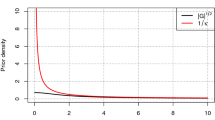Abstract
A decision problem is defined in terms of an outcome space, an action space and a loss function. Starting from these simple ingredients, we can construct: Proper Scoring Rule; Entropy Function; Divergence Function; Riemannian Metric; and Unbiased Estimating Equation. From an abstract viewpoint, the loss function defines a duality between the outcome and action spaces, while the correspondence between a distribution and its Bayes act induces a self-duality. Together these determine a “decision geometry” for the family of distributions on outcome space. This allows generalisation of many standard statistical concepts and properties. In particular we define and study generalised exponential families. Several examples are analysed, including a general Bregman geometry.
Similar content being viewed by others
References
Amari, S. (2005). Integration of stochastic evidences in population coding – theory of α-mixture. In Proceedings of the Second International Symposium on Information Geometry and its Applications, (pp. 15–21). University of Tokyo, 12–16 December 2005.
Amari, S., Nagaoka, H. (1982). Differential geometry of smooth families of probability distributions. Technical Report METR 82-7, Department of Mathematical Engineering and Instrumentation Physics, University of Tokyo.
Amari, S., Nagaoka, H. (2000). Methods of Information Geometry. Translations of Mathematical Monographs, Vol. 191. Providence, Rhode Island: American Mathematical Society and Oxford University Press.
Bernardo J.M. (1979). Expected information as expected utility. Annals of Statistics 7, 686–690
Bregman L.M. (1967). The relaxation method of finding the common point of convex sets and its application to the solution of problems in convex programming. USSR Computational Mathematics and Mathematical Physics 7, 200–217
Cover T., Thomas J.A. (1991). Elements of Information Theory. New York, Wiley Interscience.
Csiszár I. (1991). Why least squares and maximum entropy? An axiomatic approach to inference for linear inverse problems. Annals of Statistics 19, 2032–2066
Dawid A.P. (1975). Discussion of Efron (1975). Annals of Statistics 3, 1231–1234
Dawid, A.P. (1998). Coherent measures of discrepancy, uncertainty and dependence, with applications to Bayesian predictive experimental design. Technical Report 139, Department of Statistical Science, University College London. http://www.ucl.ac.uk/Stats/research/abs94.html#139.
Dawid, A. P., Lauritzen, S.L. (2006). The geometry of decision theory. In Proceedings of the Second International Symposium on Information Geometry and its Applications, (pp.22–28). University of Tokyo, 12–16 December 2005.
Dawid A.P., Sebastiani P. (1999). Coherent dispersion criteria for optimal experimental design. Annals of Statistics 27, 65–81
Eaton M.L. (1982). A method for evaluating improper prior distributions. In: Gupta S., Berger J.O. (eds) Statistical Decision Theory and Related Topics III. New York, Academic Press, pp. 320–352
Eaton M.L., Giovagnoli A., Sebastiani P. (1996). A predictive approach to the Bayesian design problem with application to normal regression models. Biometrika 83, 11–25
Efron B.(1975). Defining the curvature of a statistical problem (with applications to second-order efficiency) (with Discussion). Annals of Statistics 3, 1189–1242
Eguchi, S. (2005). Information geometry and statistical pattern recognition. Sugaku Exposition, American Mathematical Society(to appear).
Epstein E.S. (1969). A scoring system for probability forecasts of ranked categories. Journal of Applied Meteorology 8, 985–987
Gneiting, T., Raftery, A. E. (2005). Strictly proper scoring rules, prediction, and estimation. Technical Report 463R, Department of Statistics, University of Washington.
Good, I.J. (1971). Comment on “Measuring information and uncertainty” by Robert J. Buehler. In V.P. Godambe, D.A. Sprott(Eds.) Foundations of Statistical Inference, (pp. 337–339)Toronto: Holt, Rinehart and Winston.
Grünwald P.D., Dawid A.P. (2004). Game theory, maximum entropy, minimum discrepancy, and robust Bayesian decision theory. Annals of Statistics 32, 1367–1433
Lauritzen, S. L. (1987a). Conjugate connections in statistical theory. In C. T. J. Dobson(Ed.) Geometrization of Statistical Theory: Proceedings of the GST Workshop, (pp. 33–51) Lancaster: ULDM Publications, Department of Mathematics, University of Lancaster.
Lauritzen, S. L. (1987b). Statistical manifolds. In Differential Geometry in Statistical Inference, IMS Monographs(Vol. X, pp. 165–216) Hayward, California: Institute of Mathematical Statistics.
Murata N., Takenouchi T., Kanamori T., Eguchi S. (2004). Information geometry of U-boost and Bregman divergence. Neural Computing 16, 1437–1481
Tsallis C. (1988). Possible generalization of Boltzmann–Gibbs statistics. Journal of Statistical 52, 479–487
Author information
Authors and Affiliations
Corresponding author
About this article
Cite this article
Dawid, A.P. The geometry of proper scoring rules. AISM 59, 77–93 (2007). https://doi.org/10.1007/s10463-006-0099-8
Received:
Revised:
Published:
Issue Date:
DOI: https://doi.org/10.1007/s10463-006-0099-8




